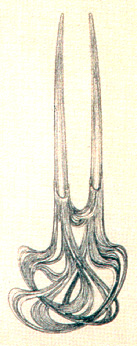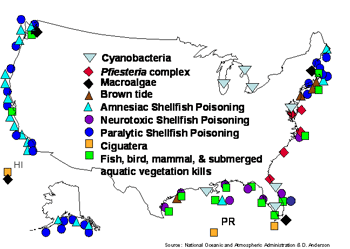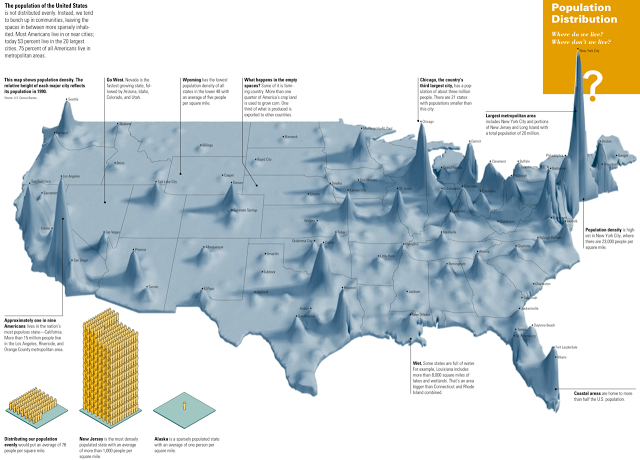dinoflagellate bloom | bacterial predators | sources
Mar. 12, 2013 — "When Gulf of Mexico algae don't get enough nutrients, they focus their remaining energy on becoming more and more poisonous to ensure their survival, according to a new study by scientists from North Carolina State University and the National Oceanic and Atmospheric Administration.
The study shows that harmful and ubiquitous Karenia brevis algae, which cause red tide blooms across the Gulf of Mexico, become two to seven times more toxic when levels of phosphorus, a major algal nutrient found in fertilizers and human waste, are low. Like wearing a suit of armor, producing highly toxic cells allows the algae to defend themselves against opportunistic waterborne grazers like zooplankton.
Red tide blooms in the Gulf are linked to fish kills and other ecological and economic damage in the region, and are also linked to respiratory ailments in humans.
Drs. Rance Hardison and Damian Shea, co-authors on a paper appearing online in the journal PLOS ONE, say that the findings could help coastal managers make better predictions about the harmful effects of red tide blooms.
'Public-health managers can test phosphorus levels in waters across various Gulf locations,' Hardison said, "and know that low levels could indicate highly toxic red tide blooms."
'At the end of a red tide bloom, when the nutrients are used up, K. brevis cells produce a burst of toxicity. Now we understand the biological mechanism behind some of the varied toxic levels seen in Gulf algal cells,' Shea, an NC State professor of biology and environmental toxicology, said."
"Red Tide Killer Identified: Bacteria Gang Up On Algae, Quashing Red Tide Blooms"
May 6, 2008 — "Researchers at Scripps Institution of Oceanography at UC San Diego have identified a potential 'red tide killer.' Red tides and related phenomena in which microscopic algae accumulate rapidly in dense concentrations have been on the rise in recent years, causing hundreds of millions of dollars in worldwide losses to fisheries and beach tourism activities.
"The work in the laboratory showed that the bacterium has to attach directly to the dinoflagellate to kill it," said Mayali, "and we found similar dynamics in the natural bloom."
Franks said he found it a bizarre concept of scale that Lingulodinium dinoflagellates { previously named, Gonyaulax polyedra, a holophytic marine dinoflagellate which is bioluminescent}, which at 25 to 30 microns in diameter are known to swim through the ocean with long flagella, or appendages, are attacked by bacteria that are about one micron in size and can't swim.
"It's somewhat shocking to think of something like three chipmunks attaching themselves to an elephant and taking it down," said Franks.
While the RCA cluster's role in the marine ecosystem is not known, Azam, a distinguished professor of marine microbiology in the Marine Biology Research Division at Scripps, said harmful algal blooms are an important problem and consideration must be given to the fact that red tide dinoflagellates don't exist in isolation of other parts of the marine food web. Bacteria and other parts of the "microbial loop" feed on the organic matter released by the dinoflagellates and in turn the dinoflagellates are known to feed on other cells (including bacteria) when their nutrients run out."
Sources:
University of California - San Diego (2008, May 6). Red Tide Killer Identified: Bacteria Gang Up On Algae, Quashing Red Tide Blooms. ScienceDaily. Retrieved May 15, 2013, from http://www.sciencedaily.com /releases/2008/05/080501125429.htm. 5-15-13
http://botany.si.edu/references/dinoflag/Taxa/Lpolyedrum.htm
Science News. "When Hungry, Gulf of Mexico Algae Go Toxic," Science Daily. Mar. 12, 2013. 5|15|13.
Donnie Ransom Hardison, William G. Sunda, Damian Shea, Richard Wayne Litaker. Increased Toxicity of Karenia brevis during Phosphate Limited Growth: Ecological and Evolutionary Implications. PLoS ONE, 2013; 8 (3): e58545 DOI: 10.1371/journal.pone.0058545
"Karenia brevis is the dominant toxic red tide algal species in the Gulf of Mexico. It produces potent neurotoxins (brevetoxins [PbTxs]), which negatively impact human and animal health, local economies, and ecosystem function. Field measurements have shown that cellular brevetoxin contents vary from 1–68 pg/cell but the source of this variability is uncertain. Increases in cellular toxicity caused by nutrient-limitation and inter-strain differences have been observed in many algal species."
"Blooms of the toxic dinoflagellate Karenia brevis produce a suite of structurally related neurotoxins, brevetoxins (PbTxs), which adversely affect both human and ecosystem health."
"Shellfish feeding on K. brevis accumulate PbTxs, which can lead to neurotoxic shellfish poisoning (NSP). NSP symptoms in humans include gastrointestinal problems, nausea, vomiting, dizziness, slurred speech, numbness of lips, mouth and tongue, and respiratory distress [2],[3]. Exposure is enhanced when K brevis cells are disrupted by breaking waves and form toxic aerosols [4]. Onshore winds transport these aerosols over beaches and nearshore communities, causing respiratory related illnesses [4]–[6]. PbTxs produced by K. brevis also cause the intoxication and death of marine organisms including copepods, fish, bottlenose dolphins and manatees [7]–[10].




